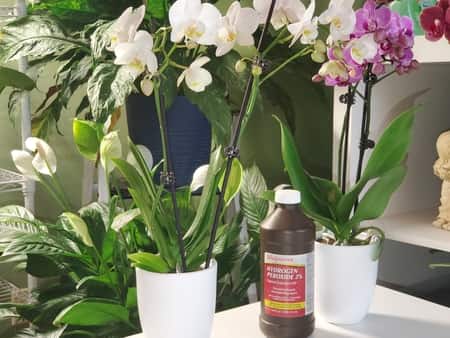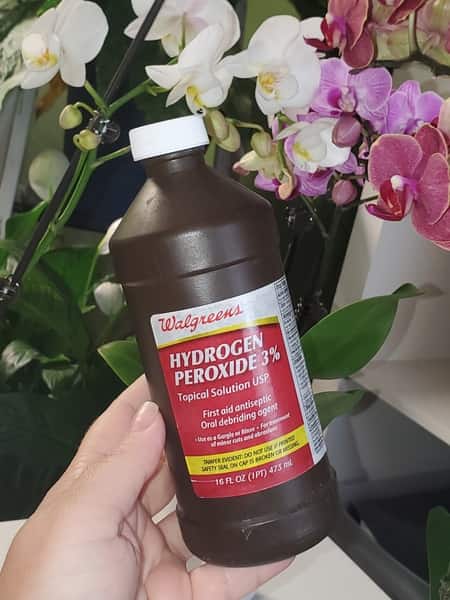Hydrogen Peroxide has been used to clean orchids for a long time. It is known that hydrogen peroxide foams, bringing dirt and microbes to the surface, that is why it is used at home for minor cuts and wounds. Yet, have you ever thought that hydrogen peroxide could be harming your orchid?
Does Hydrogen Peroxide harm the orchid? Although Hydrogen Peroxide does have antimicrobial properties, it is not recommended for orchid care. The oxidizing properties of Hydrogen Peroxide on your orchid roots will burn and destroy the healthy velamen that protects the roots, hindering their absorption characteristics. Instead of only hindering bacteria, Hydrogen Peroxide also hinders healthy orchid growth.
The chemical composition of hydrogen peroxide
To understand how hydrogen peroxide reacts with your orchid, you need to comprehend its chemical structure and reactions. I’m not a chemist and so this explanation will be simple and straightforward, getting to the point of where it matters: your orchids.

Hydrogen peroxide is H2O2. The unstable bond that holds the two hydrogen molecules and the two oxygen molecules is extremely weak and reacts by oxidation with almost everything it encounters. This reaction can produce two free elements of oxygen bonded to hydrogen (OH).
Since both of these elements are gases, the result is idealized in orchid care—a way to promote air circulations in places where air was previously denied, like roots.
A hopeful yet wrong assumption that hydrogen peroxide will somehow ventilate a dying orchid has become the new fad of orchid care. As a way to provide more gas exchange to places that have been waterlogged, hydrogen peroxide is applied to black, soggy, mushy, and dead roots.
Most people who advocate in using hydrogen peroxide will use it on roots that suffer from root rot, or will use it after cleaning out the old medium before a repot. It would be a good idea, if (and only if) that was the only reaction that hydrogen peroxide goes through.
Hydrogen peroxide can also result in another chemical reaction, forming one free oxygen and water (H20). The end result is water…more water. In this sense, to use hydrogen peroxide on a soaking root that has too much water already, would be to provide it with more water. Giving your drowning orchid a drink does not help it. The one free Oxygen element has little effect on the bacteria-infected roots.Check out the video about Hydrogen Peroxide
https://www.youtube.com/embed/ZAxyVf4BOrA
Hydrogen Peroxide Kills Bacteria and Live Orchid Roots
Hydrogen peroxide has been used in the past (and wrongfully still is used today) in minor lacerations. Used only to treat minor wounds, it was cheaper and more accessible during war times. This is no longer the case, but the idea that was brought to life during the war has held on.
Peroxide interacts with blood, inhibiting the propagation of microorganisms—that much is true. This technique of applying Hydrogen Peroxide is no longer recommended because although it does remove the microbes in an action that brings them to the surface, it also kills live tissue around the open wound.
Scarring will be worse since the live tissue that is around the wound will die off when reacting with hydrogen peroxide. Therefore, the wound never heals properly. You have a clean wound that never closes.
It is successful in removing bacteria, though.
That is why it is used as a form to inhibit black root on stem, crown and orchid roots.
The problem with this assumption is that we have a tendency to think of all microorganisms as harmful. These bad boys will be the target of everything evil in our orchid and we distill all our rage onto these little lifeforms.

Orchids also have beneficial bacteria. Not all microorganisms are harmful to your orchid, and in some cases, if it weren’t for the fungi mycorrhizae, orchid seeds would never propagate. This beneficial relationship is the only way orchids grow in the wild.
When you pour hydrogen peroxide onto the orchid potting medium, the oxidizing properties will oxidize everything in its path—good roots included. Just as the skin wound that never heals because peroxide kills it, good healthy roots die. Healthy velamen is harmed and burnt, butchering the cells that react with the peroxide.
Is killing the good, healthy roots worth trying to halt black root? Other methods and chemicals come highly suggested, which you can check out on this article about pesticides, fungicides, and treatments. None of these other methods harm the orchid roots as Hydrogen Peroxide does.
Hydrogen Peroxide Bleaches Orchid Roots
Hydrogen Peroxide is also known for it’s bleaching properties. Marylin Monroe is known to have used it to get a more intense blonde-color and the fad caught on. Blonds appeared everywhere—me included. The double bond in hydrogen peroxide absorbs light. When a chemical reaction occurs, the bond breaks and destroys pigment in whatever is around it.
Hair is not the only item hydrogen peroxide removes color from. It is also used on wood, tile, and textiles. 60% of the hydrogen peroxide used is sold to paper and pulp-bleaching industries. As mentioned before, hydrogen peroxide will remove all the pigment, bleaching the surfaces it encounters. Do you really want blonde orchid roots?
Hydrogen Peroxide Cleanses Orchid Roots…to the Extreme
Hydrogen peroxide has been studied since 1799 when the first chemists were studying a formula to purify air. (Side note: if you’re wondering if orchids or other household plants purify air, read this article. The results might surprise you.) In 1824, hydrogen peroxide, called oxygenated water, was the result of their studies.
Concentrated Hydrogen peroxide, called high-test peroxide, is extremely reactive and for that reason is used in rocket propulsion. The intense explosion it produces at high temperatures propels the rocket forward. Hydrogen peroxide cannot be boiled since it explodes before reaching its boiling point.
On the other hand, hydrogen peroxide is extremely weak when it interacts with light. It decomposes extremely fast. To avoid this possibility hydrogen peroxide is sold and stored in dark, thick bottles. Is it that important to add hydrogen peroxide to the roots, the same product that could explode if boiled?
Hydrogen peroxide is also a cleaning solution, found in the common detergents such as Tide and OxiClean laundry Detergent. They use hydrogen peroxide as mild bleaches, promoting the cleansing and removal of impurities. I can’t imagine applying laundry detergent to my orchid’s roots would be beneficial.
Because it does remove microbes from the surfaces of instruments, Hydrogen peroxide is safe to use when sterilizing scissors, razor blades, or other pruning material for orchids. The FDA has approved it as a safe antimicrobial agent.
And to end this article, hydrogen peroxide is also used in glow sticks. Snap the stick, you’re glowing. But your orchid is not. Please, please, please, refrain from using hydrogen peroxide on orchids. If that is the only product you have and no other chemical treatment is available, it’s worth a shot.
I have used it before and confess that I followed that fad before actually researching what the effects would be on my orchid. In fact, there are probably articles on here that I have said to use Hydrogen Peroxide—live and learn. I no longer do this since paying a few more dollars for a decent anti-fungal is thousands of times better.
Don’t Stop Learning!
If you want to be included in more information and get a 14-page fertilization guide, please sign up for my newsletter. I don’t spam, but send emails out bi-monthly with some curious topics of interest. If you want more information, click here to go to a specific page on this website where I explain it more in detail.

Also, if you are looking for an orchid journal to keep your notes specifically about orchid care, check out my 2 solutions for that on this page. If note-keeping isn’t your thing, then there is a free excel spreadsheet that you can download. Click here for more information on how to do that.
If you subscribe to my newsletter, I will send you a 14-page guide on the main tips of orchid fertilizer. It is downloadable and you can print it out on your computer. I designed the guide to double up as a coloring book, just to make it fun.
Further Reading Suggestions:
Don’t just take my word for what is written here. Continue researching other articles about using Hydrogen Peroxide on orchids, because everyone has a different point of view and unique techniques that work for them. Here are a few other articles from other websites if you’d like to continue your research on orchid care and Hydrogen Peroxide:
-“Compound Summary of Hydrogen Peroxide ” written by National Center for Biotechnology Information, published on the National Library of Medicine talks about everything you could possibly want to know about Hydrogen Peroxide. I found the part where toxicity interesting since it was tested on numerous species and the results were recorded in a graph.
” written by National Center for Biotechnology Information, published on the National Library of Medicine talks about everything you could possibly want to know about Hydrogen Peroxide. I found the part where toxicity interesting since it was tested on numerous species and the results were recorded in a graph.
–Title: “Hydrogen Peroxide ” written by the Division of toxicology, published on the Agency for Toxic Substances and Disease Registry talks about what Hydrogen Peroxide does. Read this article–please do. This will convince you to not use Hydrogen Peroxide on your orchids, and I take a direct quote form the first page, “Exposure to hydrogen peroxide can cause irritation of the eyes, throat, respiratory airway, and skin. Drinking concentrated liquid can cause mild to severe gastrointestinal effects.” If you can’t drink it, why are you feeding it to your orchid?
” written by the Division of toxicology, published on the Agency for Toxic Substances and Disease Registry talks about what Hydrogen Peroxide does. Read this article–please do. This will convince you to not use Hydrogen Peroxide on your orchids, and I take a direct quote form the first page, “Exposure to hydrogen peroxide can cause irritation of the eyes, throat, respiratory airway, and skin. Drinking concentrated liquid can cause mild to severe gastrointestinal effects.” If you can’t drink it, why are you feeding it to your orchid?
Happy Cultivating (without Hydrogen Peroxide!)


As I lost a couple of roots to root rot and I’m completely out of work in media but the orchid media is still new could I use peroxide 3% mixed with water to cleanse the media after rinsing the media thoroughly w/ with warm water so the root rot doesn’t spread.